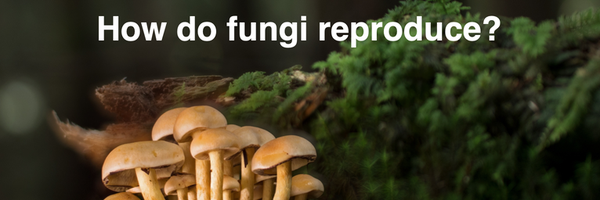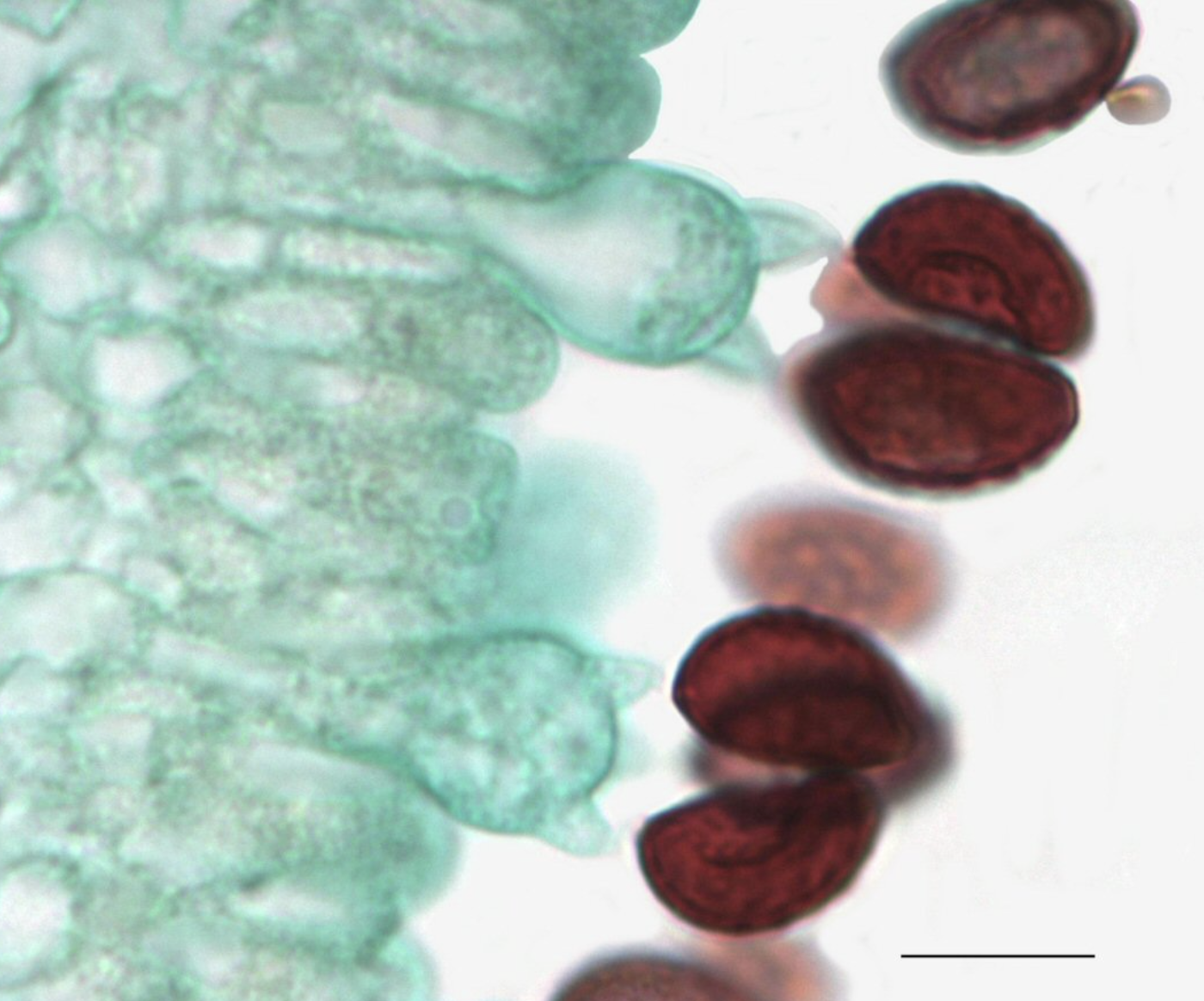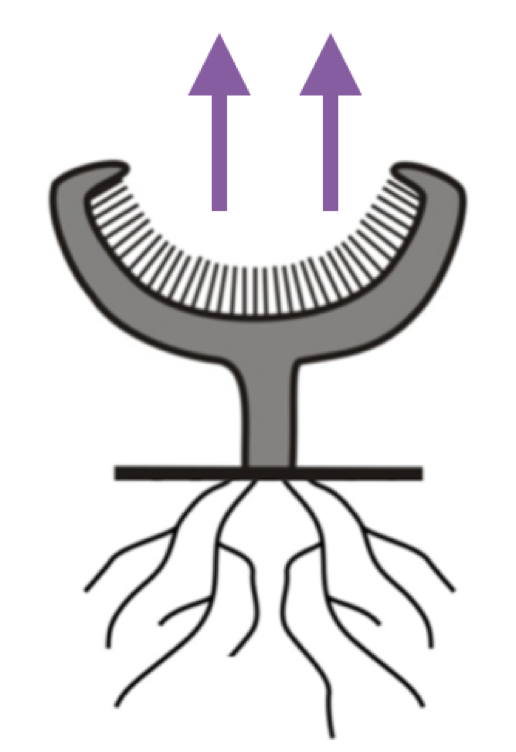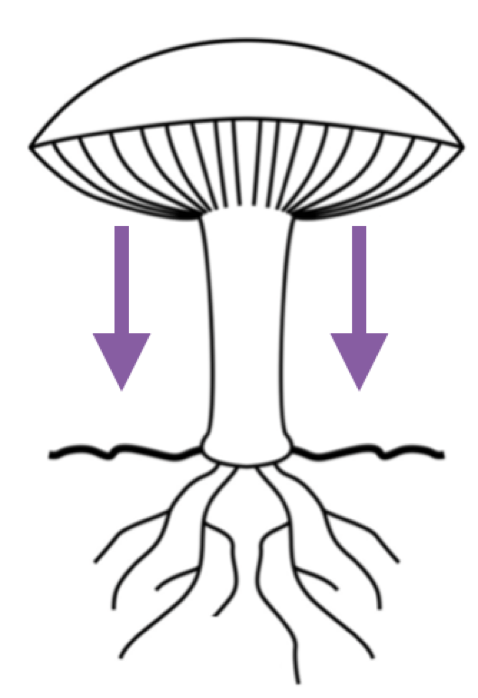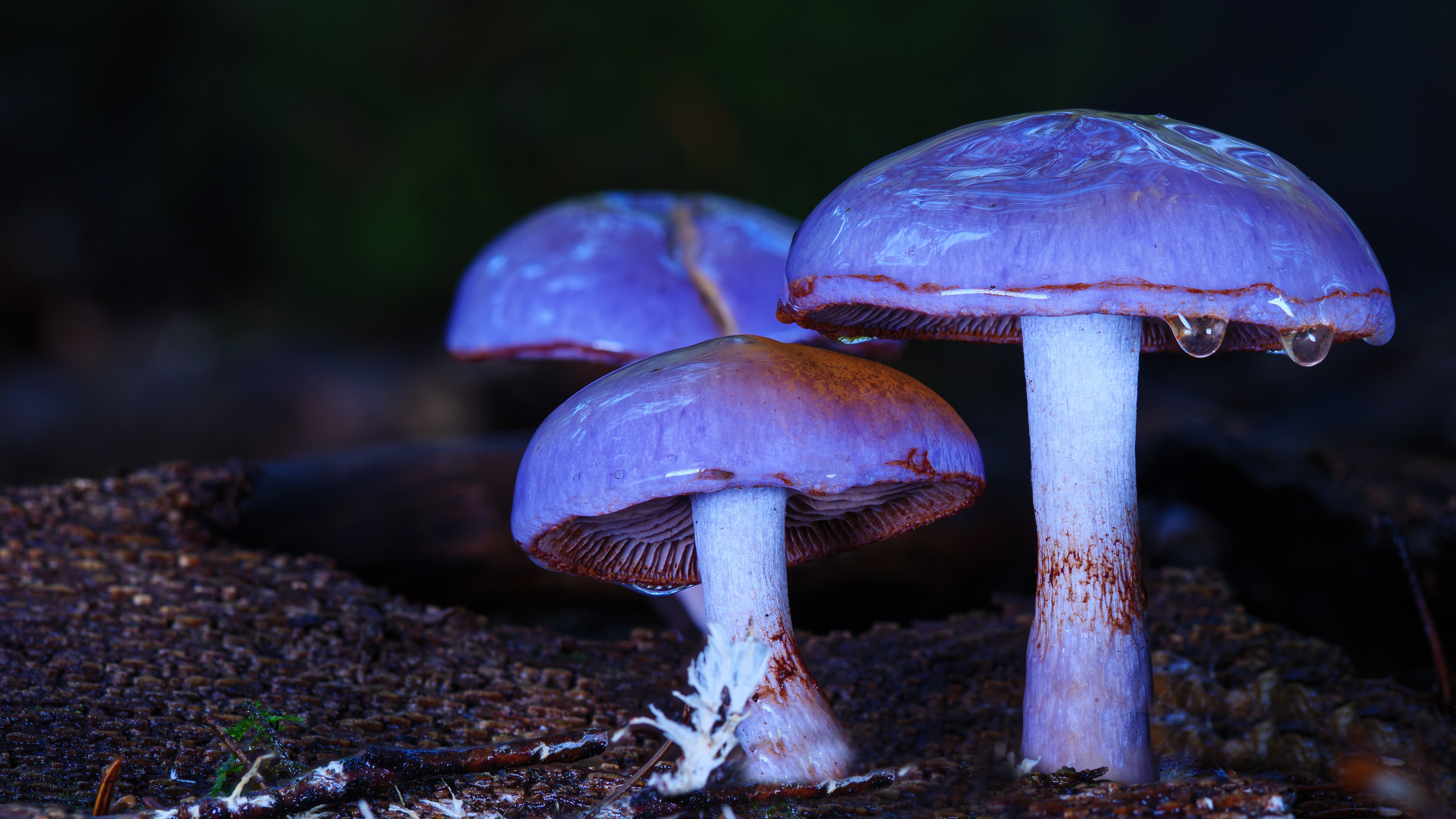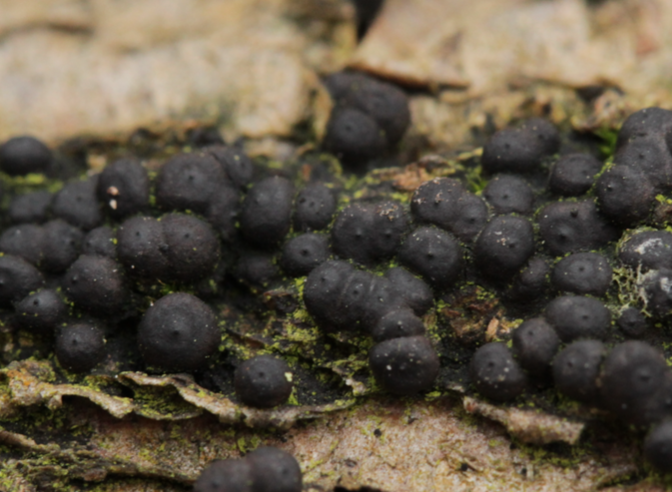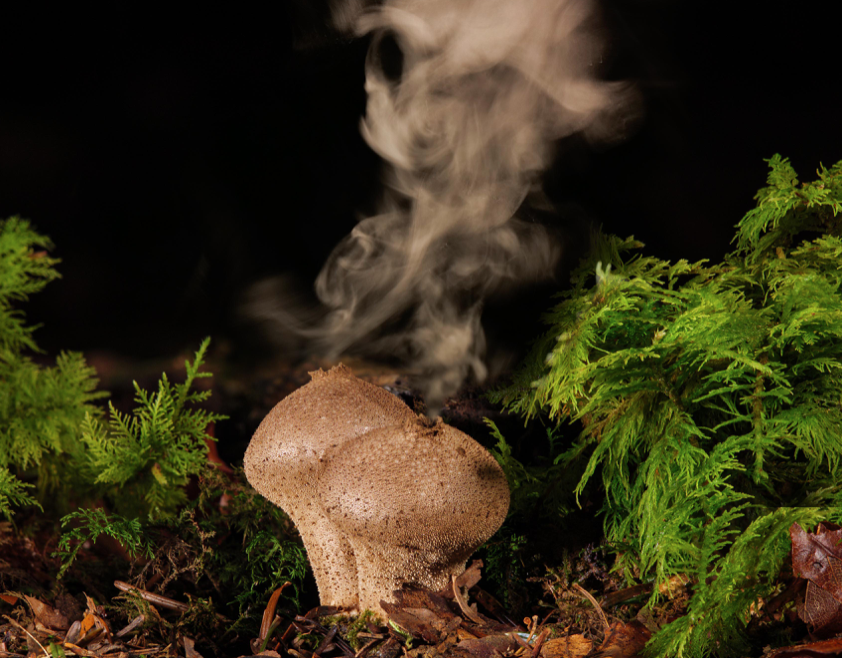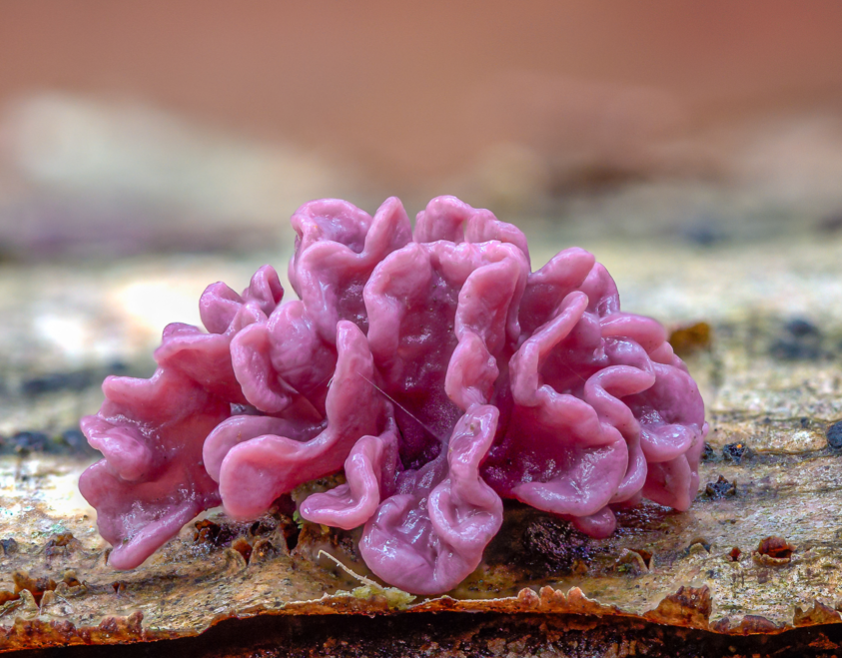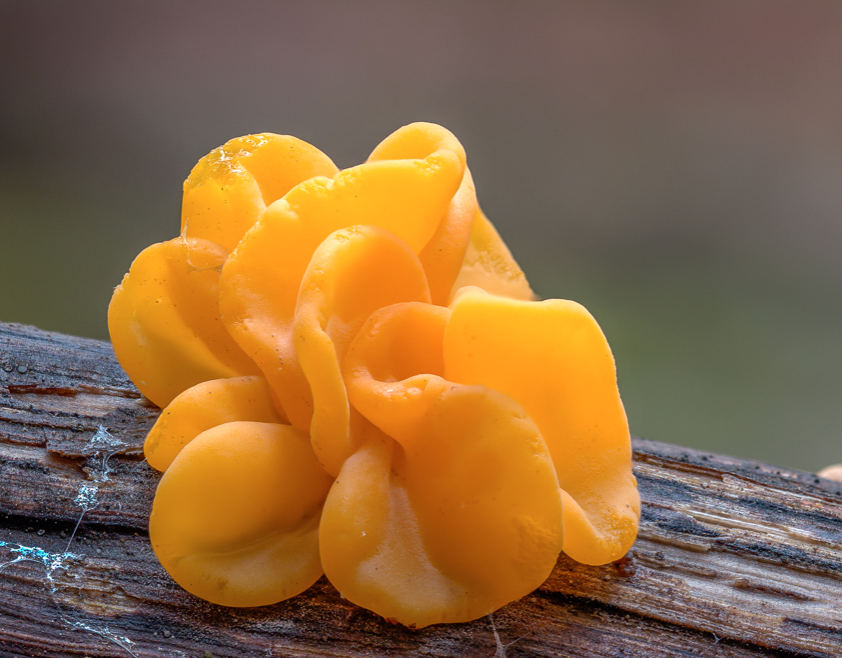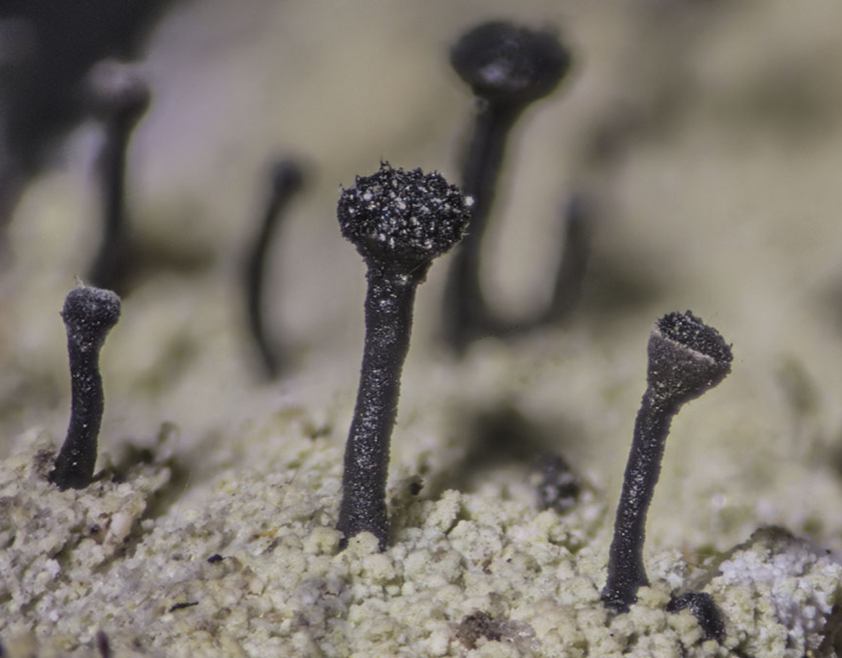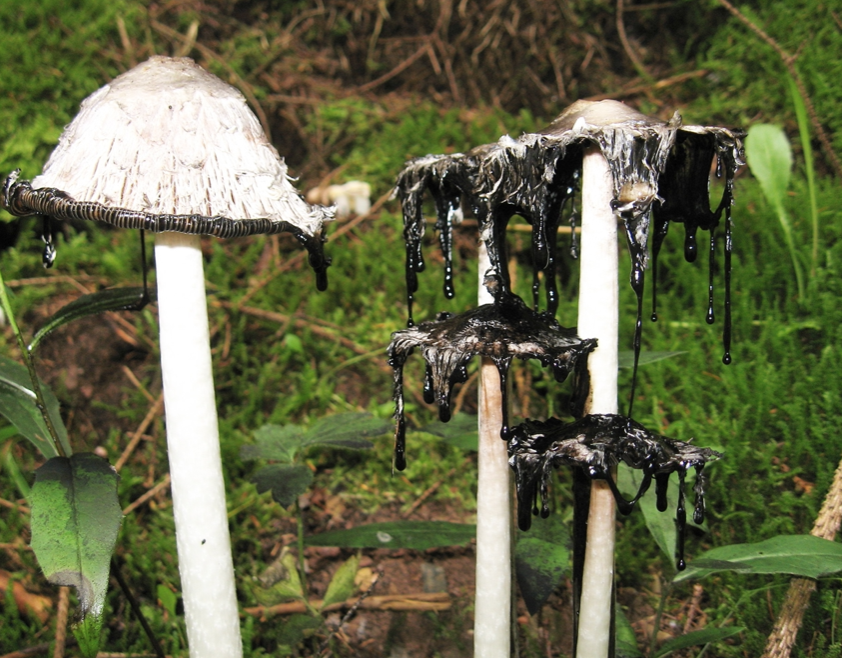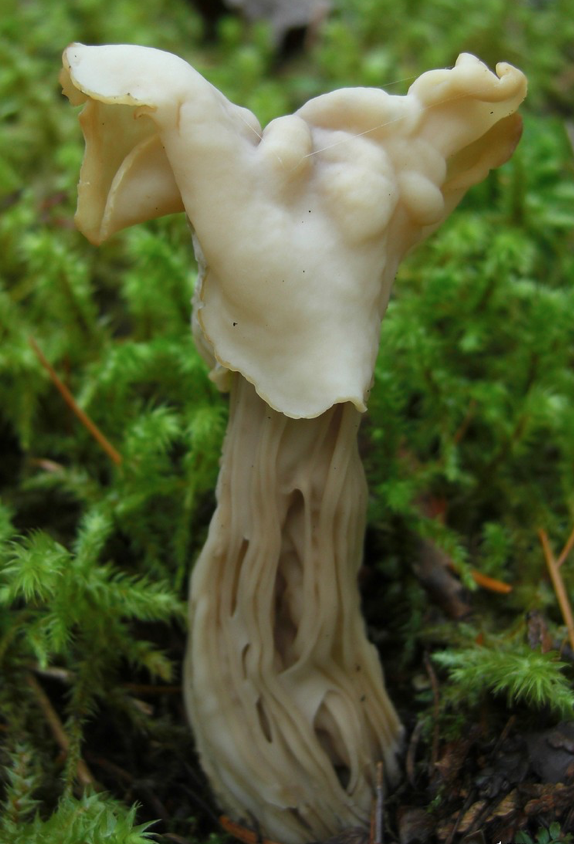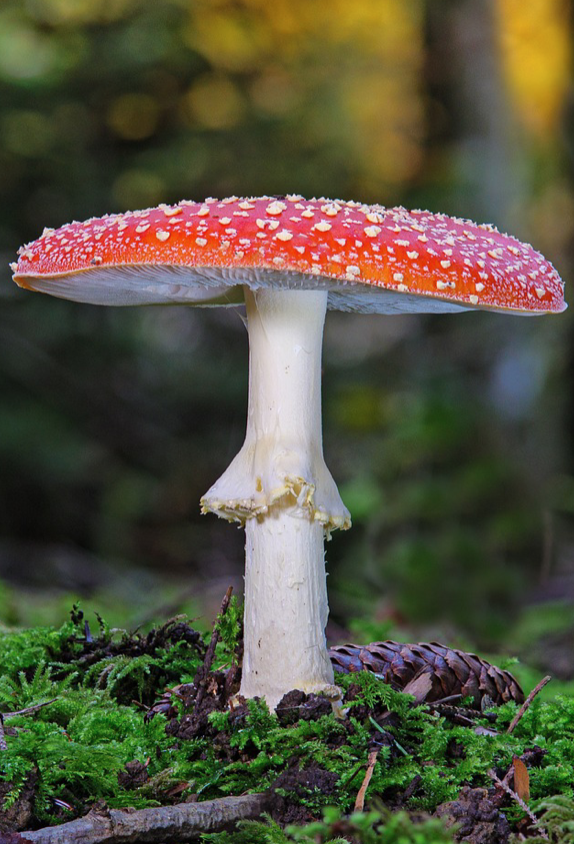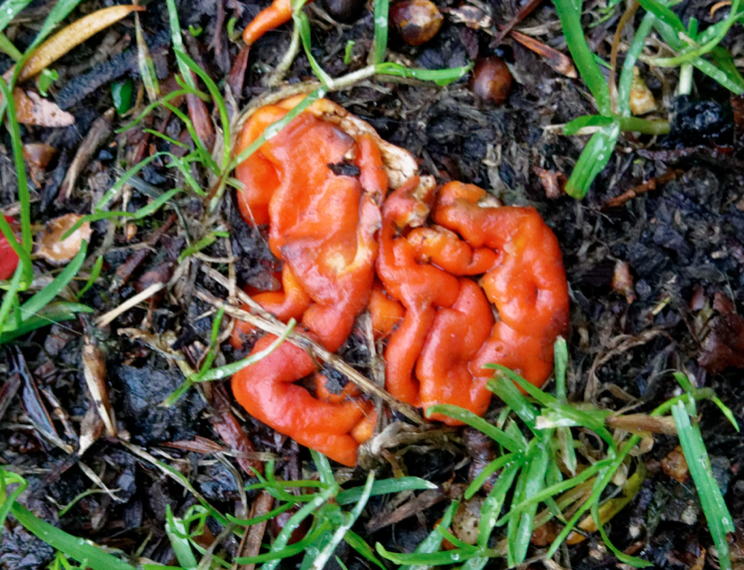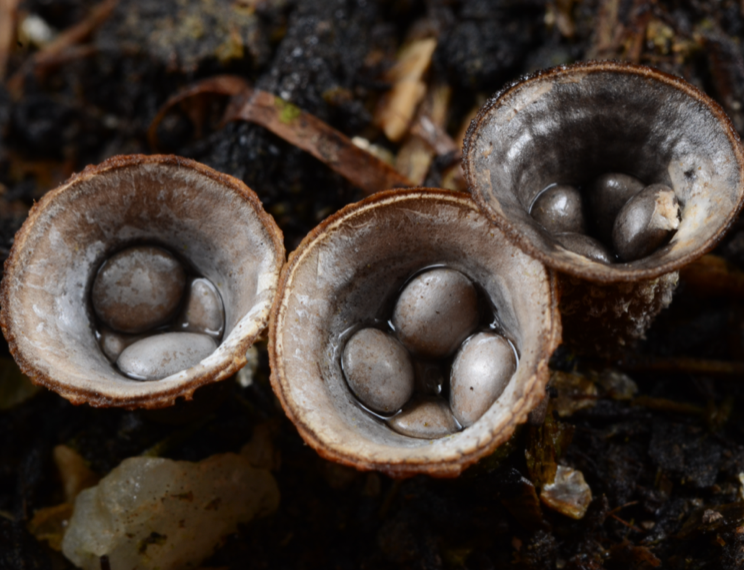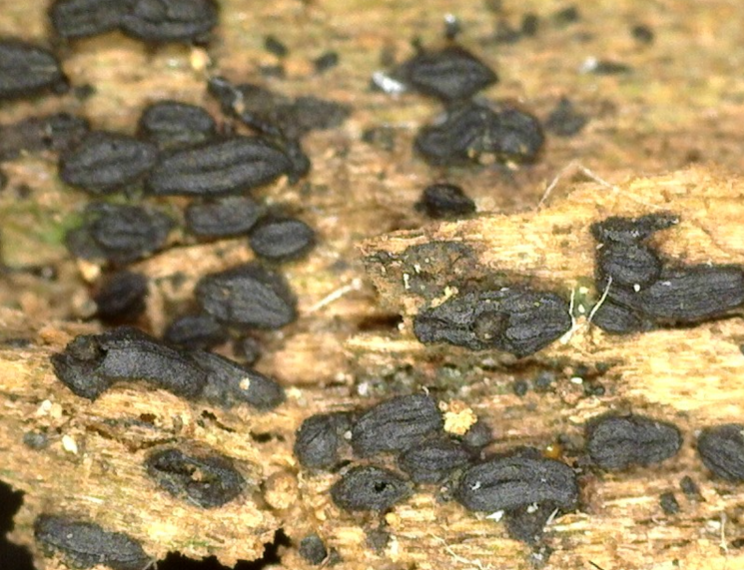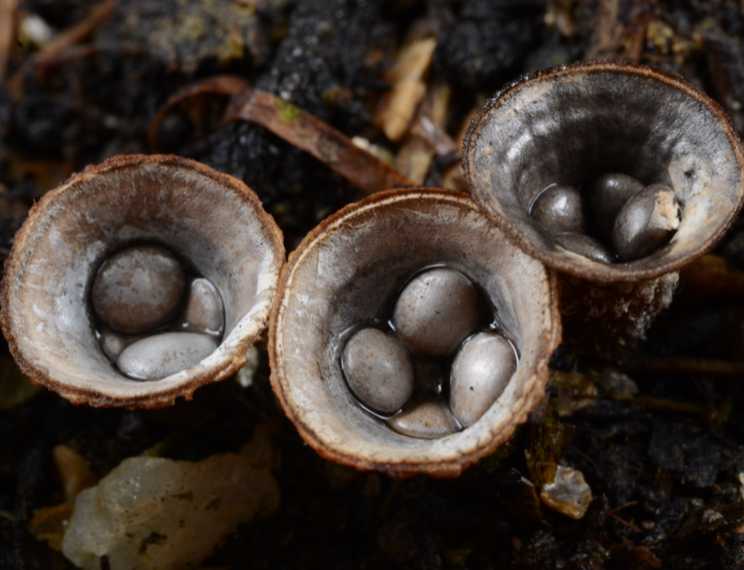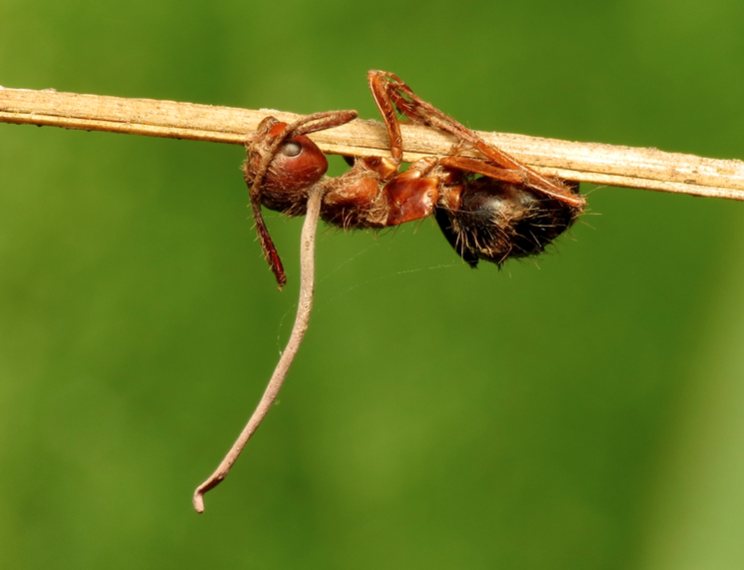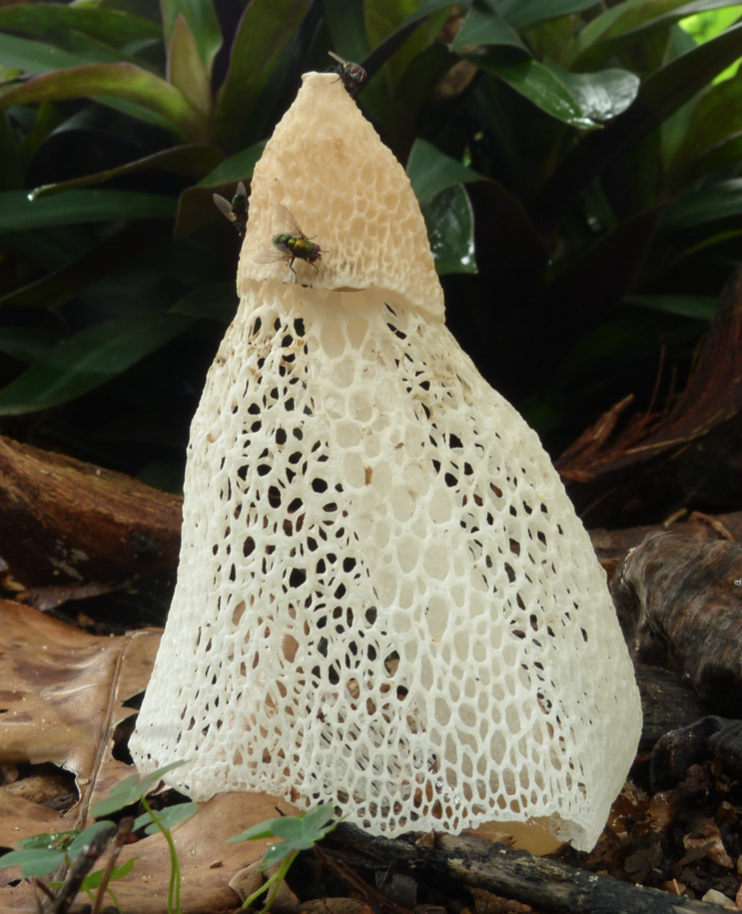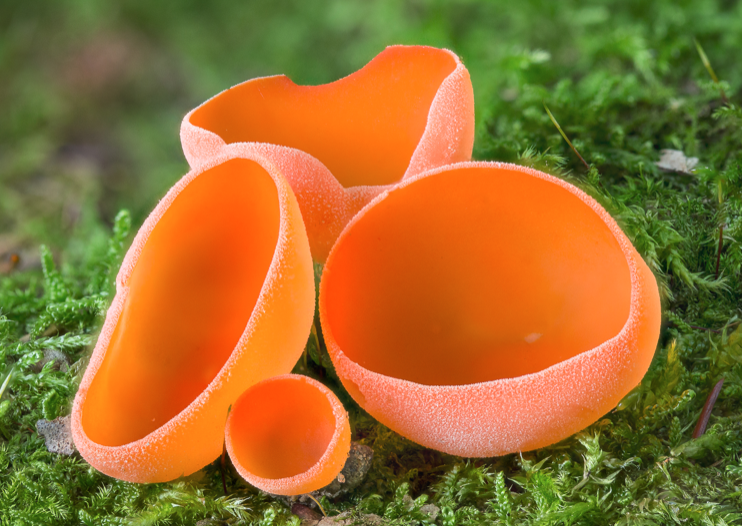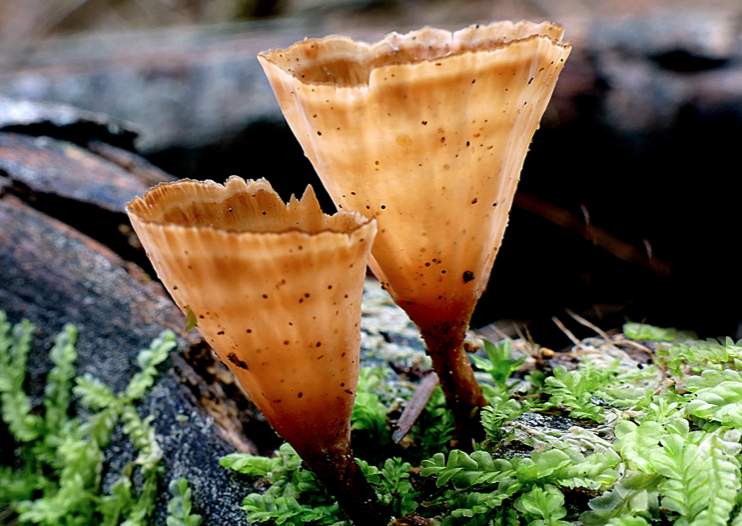Mushroom Mysteries: how do fungi reproduce?
Grade 6
Presentation
Problem
Inspiration
Last summer, I went to the Mushroom Museum in Zagreb, Croatia. It was a very interesting place and there were thousands of different types of mushrooms. I wanted to learn more about mushrooms.
In this project, I looked at a large variety of fungi and learned about their life cycle. I became most interested in how fungi reproduce, and wanted to know specifically how mushroom-forming fungi reproduce.
Background
Evolution and Taxonomy
Life evolved from the Last Universal Common Ancestor, developing into 3 main groups of organisms.
The 3 main groups, or Domains, of organisms are:
- Bacteria
- Archaea
- Eukaryota
The Eukaryota further evolved into 4 Kingdoms:
- Protists
- Plants
- Fungi
- Animals
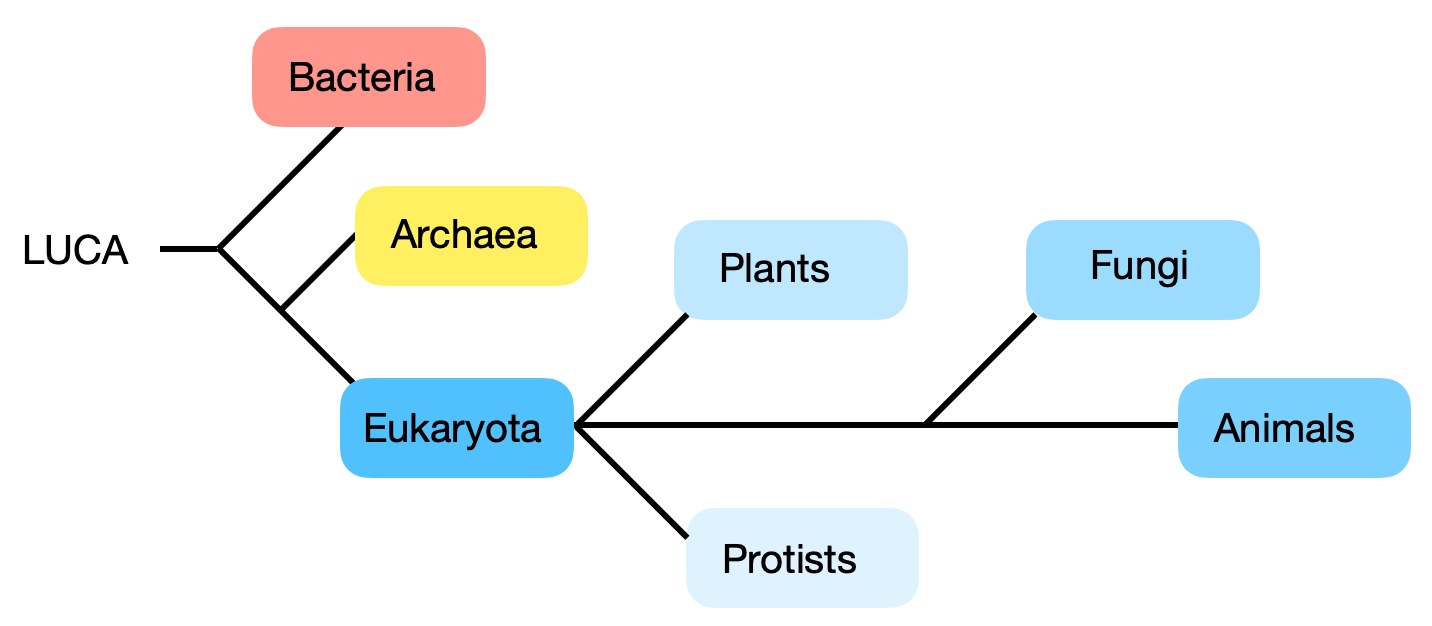
These 4 Kingdoms vary in several characteristics, particularly the material that makes up the external cell border and the mode of nutrition the kingdom uses.
Fungi evolved 1 billion years ago. The first fungi were simple single-celled organisms that lived in water. Some fungi moved onto land as the oceans got too crowded. Some fungi stayed as single cells, and others developed multicellular forms. Many fungi developed the ability to reproduce asexually and sexually, thereby benefiting from the advantages of each means of reproduction. Also, fungi were likely very successful because they developed a unique mode of nutrition.
Fungus Fact: Fungi are more closely related to Animals than to Plants. In fact, humans share 50% of our DNA with Fungi.
Kingdom of Fungi
Members of the Fungi Kingdom are defined by these features:
- there is a nucleus in each cell (eukaryotic)
- the cell wall is made of chitin (a fibrous material)
- they are heterotrophic (eat other organisms for food) (hetero = “other” + trophe = “nourishment”)
- they are absorbotrophic (digest nutrients outside the cell and then absorb the nutrients)
- they reproduce by spores
The Kingdom of Fungi is incredibly diverse. There are almost 150,000 named species of fungus identified, but scientists suspect that there are around 3 million possible fungus species. This means that only 5% of members in this Kingdom are known. Fungi live on every continent, including Antarctica.
Fungus Fact: There are 5 to 6 times as many known fungi as there are plants.
Fungi are about 1 billion years old. They have survived every extinction event, and have evolved into many different unicellular and multicellular forms.
The Fungus Kingdom is divided into several Phyla, but scientists are still debating how many groups they should be organized into. Most fungi belong to 2 main phyla: Ascomycota and Basidiomycota. The remainder belong to the other phyla (anywhere from 3 to 15 other phyla, depending on the scientific source).
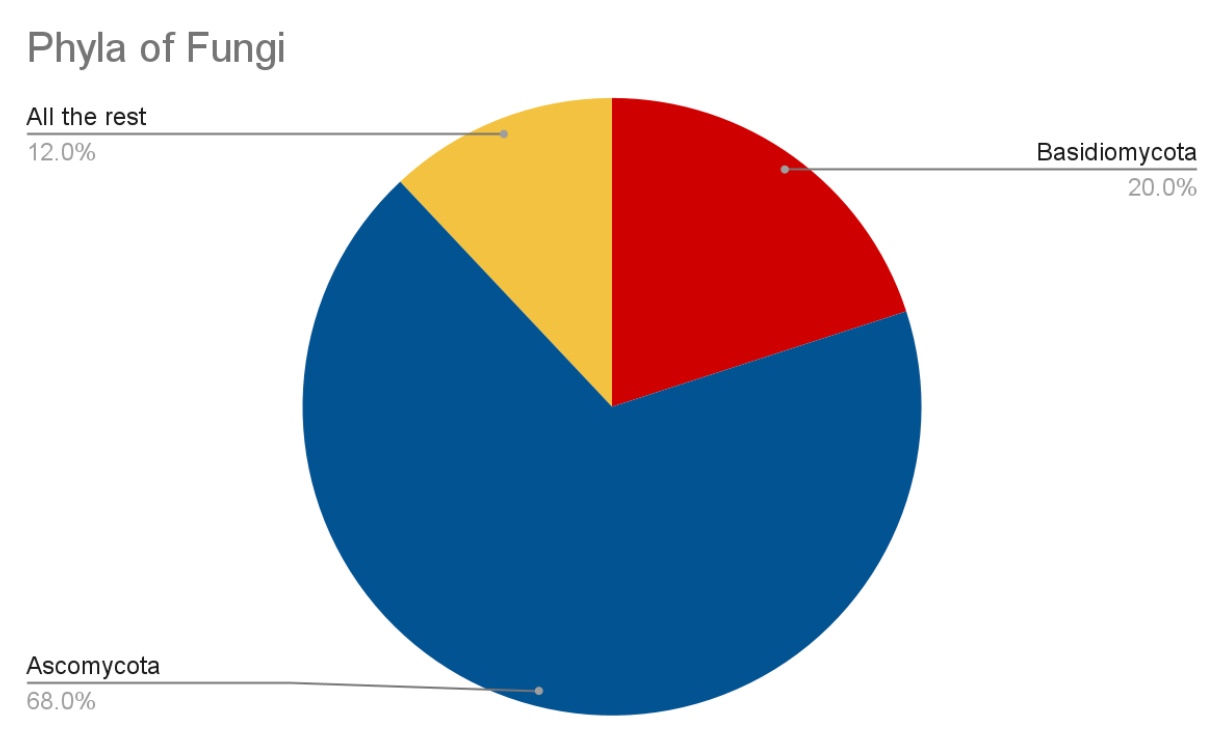
The majority of fungi are microscopic (microfungi), including unicellular organisms, yeasts, and molds. The minority, about 10%, are easily visible (macrofungi). Almost all macrofungi are either Ascomycota or Basidiomycota.
All mushrooms are fungi, but not all fungi are mushrooms.
I have included some diagrams that I made from my logbook. These diagrams show a variety of mushrooms in the Ascomycota and Basidiomycota phyla.
Ascomycota:
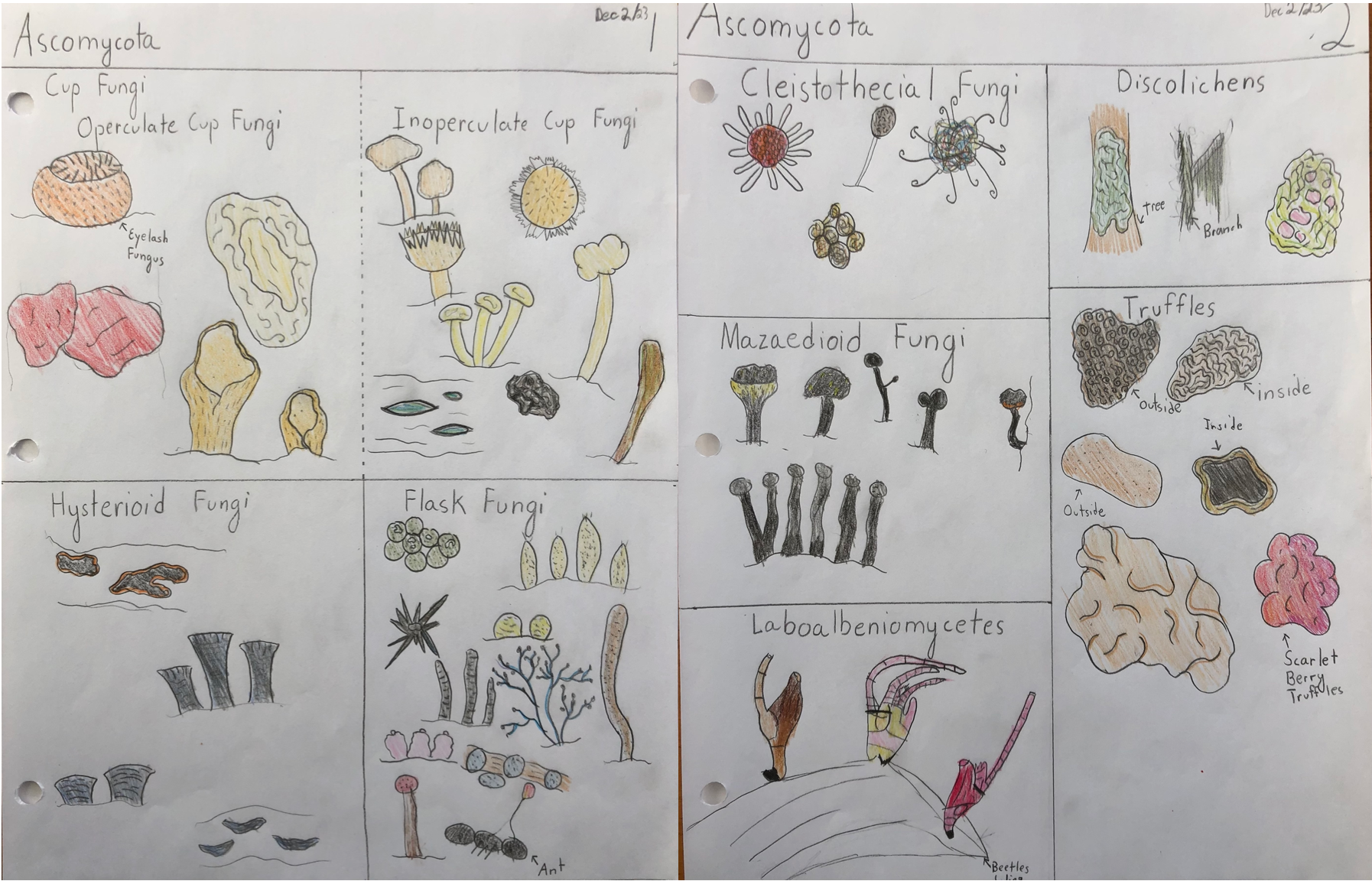
Basidiomycota:
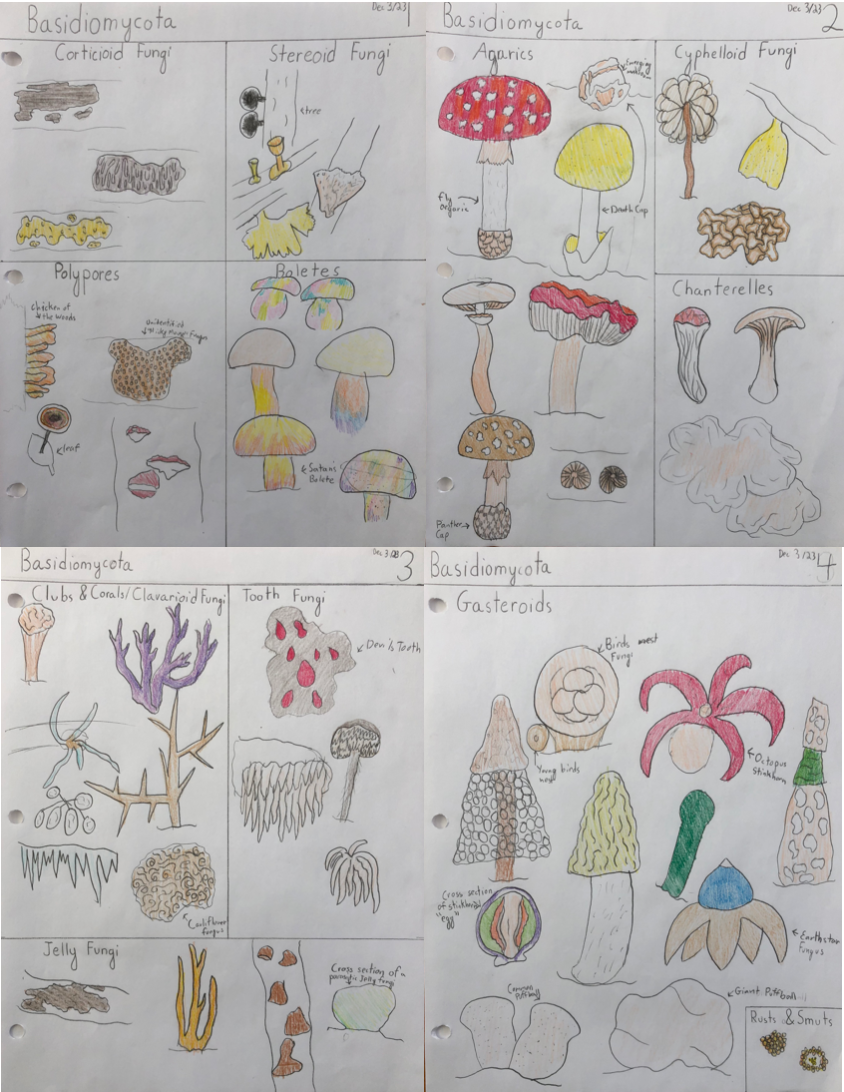
Life of Fungi
Among the members of the Ascomycota and Basidiomycota phyla, there are about 14,000 species that form a mushroom as part of their life cycle. It is these fungi that are the focus of further research.
In its life cycle, the fungus spends most of its life in the vegetative form. The basic structure is the hyphae: long chains of individual fungal cells joined together. When several hyphae come together, they form a network known as a mycelium.
Fungus Fact: The biggest living organism in the world is a fungus! The Humongous Fungus is an individual Armillaria ostoyae with a mycelium that covers 10 square kilometers.
The main activities of the mycelium are growing and feeding. The fungus feeds by secreting enzymes that disperse in the food source that it is growing on. The enzymes break down the nutrients into molecules that are small enough to enter the fungal cells. The mycelium can send out hyphae to search for food.
The fungus spends a smaller amount of time in the reproductive form. Many species can reproduce asexually and sexually. However, sexual reproduction has the advantage of increasing genetic diversity in the species.
Role in the Environment
Fungi have two main roles in the ecosystem: decomposition and mutualism. Fungi can switch between various roles.
Decomposers take advantage of or sometimes harm other organisms for resources. Decomposers can be saprophytic or parasitic.
- Saprophytic (sapro = “rotten or putrid” + phyton = “plant”) fungi decompose already dead or decomposing matter (often dead plants, as well as dead animals, fungi, or feces). This recycles nutrients back to the soil. Without decomposers, dead plant and animal matter would pile up on the forest floor.
- Parasitic (parasitos = “eating at another’s table”) fungi use or take over the resources of another living organism to gain nutrients.
Mutualistic fungi create symbiotic relationships, which is where both species gain something from the relationship. Mutualistic fungi can have a symbiotic relationship with trees and plants. In these relationships, they can be mycorrhizal or endophytic.
- Mycorrhizal (myco = “fungus” + rhiza = “roots”) relationships are the symbiosis between plant roots and fungal mycelium. 90% of land plants have these connections. The benefits include: exchange of nutrients and water, protection from invaders, and better communication between trees.
- Endophytic (endo = “within” + phyton = “plant”) relationships involve the fungus living inside the cell walls and leaves of plants.
- In addition, some mutualistic fungi have relationships with bacteria or algae (by forming lichen), or with animals (such as ants or termites).
Fungi are very important for people too. There are many ways people benefit from fungi:
- Food source and food production, including bread baking, cheese making, beer brewing, and chocolate production
- Health, including production of antibiotics and medicines for cancer, high cholesterol, and mental health
- Industrial uses, for making wallpaper, packaging, bricks, fake leather, clothing dyes, and eco-friendly fertilizer
- Fungi help our environment, by stabilizing the forest floor and protecting against erosion, and by indicating the health and diversity of a forest
The Future is Fungi: Fungi decompose many substances, and have been able to clean up oil spills, recycle plastic, and decompose disposable diapers.
Questions
The main question of my project was focused on how mushroom-forming fungi reproduce. While doing my background research and learning about the scientific principles that are important to this topic, I developed two additional questions to explore fungal reproduction in more detail.
Main Question
How do mushroom-forming fungi reproduce?
Additional Questions
1. How do fungi increase their chances of reproductive success?
2. Do fungi in the two major mushroom-forming phyla (Ascomycota and Basidiomycota) use similar or different reproductive strategies?
Theses
The theses I developed to help me answer my questions are summarized in the table below:
| How do mushroom-forming fungi reproduce? | Fungi use mushrooms in their life cycle for sexual reproduction. Mushrooms reproduce by spores, not seeds. |
| How do fungi increase their chances of reproductive success? | Fungi make lots of spores. They spread the spores mostly by air, and not by flying insects like plants do. |
| Do fungi in the two major mushroom-forming phyla (Ascomycota and Basidiomycota) use similar or different reproductive strategies? | There are so many different types of fungi in both Ascomycota and Basidiomycota, so there are likely a lot of differences. |
Method
Scientific Principles
Three scientific principles guided my project.
1. Taxonomy and Evolution
Earth is about 4.5 billion years old. Life on Earth began about 3.7 billion years ago with simple, single-celled organisms. From these simple cells, the Last Universal Common Ancestor developed into different groups of organisms. In these 3 major groups (Domains), further evolution occurred, resulting in a large variety of organisms.
This variety can be described by grouping organisms by how closely they are related (taxonomy). Each Domain can be broken down into Kingdoms, and Kingdoms can be divided into Phyla (single: Phylum). Further sub-classifications can be described, right down to the close group level (Genus) and individual organism level (Species).
2. Evolution and Diversity
The organisms in the 4 Kingdoms evolved in response to environmental pressures. Organisms compete for nutrients, a physical environment or space to live in, and safety from predators. Some organisms stay as single cells, and some develop into multicellular forms to survive better in their environment.
Sometimes several organisms evolve similar traits or strategies in response to environmental stressors, despite not being closely related. This phenomenon is called parallel evolution.
3. Diversity through Reproduction
Some organisms reproduce asexually. This type of reproduction involves just one parent. The parent copies itself, and the offspring are genetically identical to the parent.
- Advantage: large amount of offspring can be made quickly and efficiently
- Disadvantage: because all offspring are identical, they are all vulnerable to the same threats or challenges in the environment
Many organisms have developed the ability to reproduce sexually. This type of reproduction involves two parents, so the offspring has a mix of genes from each parent. This has been described as “shuffling the genetic deck of cards” (Lim & Shu).
- Advantage: ensures diversity in offspring, which helps the species survive because different individuals can respond uniquely to threats and challenges
- Disadvantage: takes more time and resources to make genetically different offspring
Approach
I reviewed a large variety of resources: books, articles, websites, and documentaries.
While doing my research, I quickly realized that there wasn't a lot of numerical data, so I chose to look for patterns and was able to organize my findings by comparing and contrasting different species of fungi. The specific approach I used to answer each question is described in this table:
| Question | Method |
| How do mushroom-forming fungi reproduce? | I reviewed resources describing a large variety of mushrooms and identified what they have in common, to identify the basic reproductive life cycle. |
| How do fungi increase their chances of reproductive success? | I looked at information about a large variety of mushrooms to identify all the possible different strategies mushrooms use for reproductive success. I continued looking until I could find no new information. |
| Do Ascomycota and Basidiomycota use similar or different reproductive strategies? | I looked at information about Ascomycota species and Basidiomycota species, and compared the reproductive strategies of many fungi in each phyla. |
Research
To understand reproduction of mushroom-forming fungi, I looked at a wide variety of species in both the Ascomycota and Basidiomycota phyla. I will present my findings below by first describing the basic life cycle of mushroom-forming fungi and then describing strategies they use to increase reproductive success.
The Basic Life Cycle of Mushroom-Forming Fungi
The basic steps of the life cycle of mushroom-forming fungi are summarized in this diagram:
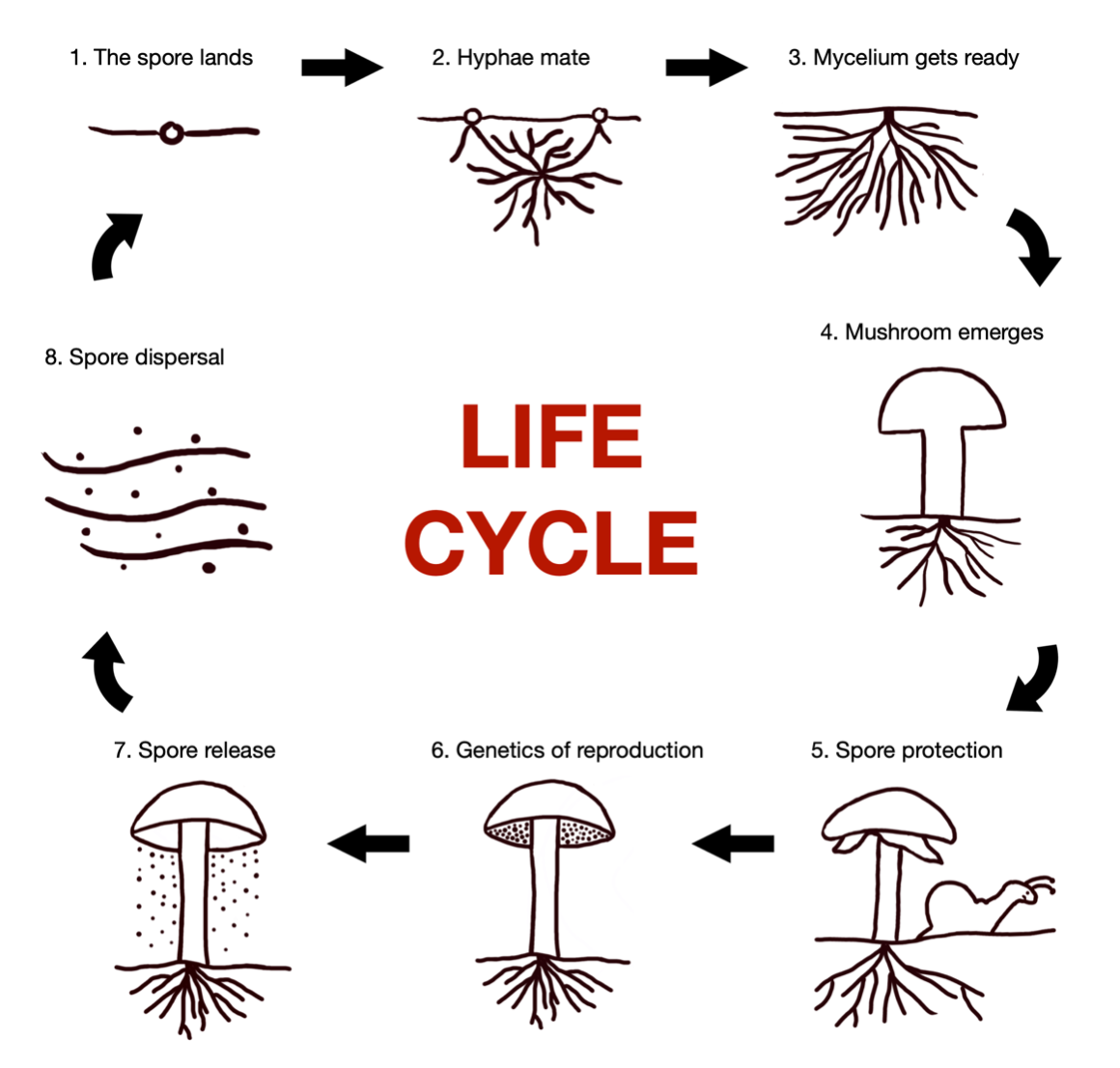
I will give more detailed information about each step in this table:
| Step |
Details |
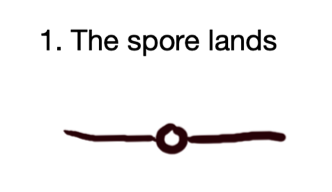 |
What are spores? A spore is a small, simple structure that contains the genetic material to make a fungus. It is the product of sexual reproduction of its parents. It has a similar function to a seed of a plant, but it is much smaller. Most spores are 3 to 10 micrometres in size.
How many spores are there? Each sporing body produces and releases millions to billions, sometimes even trillions, of spores. Fungi make some many spores because only a very small portion travel to a good environment and sporulate. Fungus Fact: It is estimated that only 1 in a billion spores successfully grow into a mycelium.
How do spores sporulate? When temperature and moisture levels are right, sporulation (also called germination) can occur. The spore absorbs water through its cell wall, which prepares it for further development. A thread-like germ tube extends and then branches to form hyphae. |
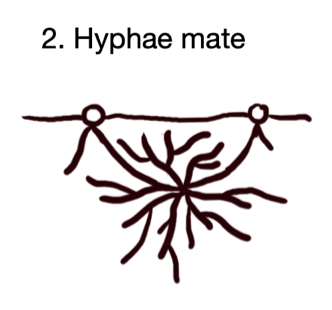 |
Compatibility and Sexes (Mating Types) As hyphae grow, they meet other hyphae. If the two hyphae are a similar sex, they will try to prevent each other’s growth. However, if the two hyphae are different sexes, they can mate. In fungi that form mushrooms, there are no male or female sexes. Instead, fungi have many sexes that are called mating types.
The Genetics of Mating Each parent hyphae consists of chains of cells, where each cell has a nucleus that contains one set of chromosomes. This is called the haploid state (one set of chromosomes). When two hyphae meet and mate, they combine cell contents. This is called plasmogamy (plasma = “molded thing” + gamos = “marriage”). The resulting mycelium has cells with two separate nuclei, one from each parent. The nuclei stay separate. When they are in this form, they are called dikaryotic. This is the most common state that mycelium is found in. It stays in this dikaryotic state until spores are ready to be formed in the mushroom. |
 |
When does a mushroom (sporing body) form? The mycelium will send out hyphae in search of food. If there are nutrients, it will keep expanding. If the mycelium consumes the resources in one area, it will often expand outwards from the centre of that area. At certain times, the mycelium will form a sporing body. This can occur immediately after mating, or sometimes weeks or months or even years later. Mushroom formation usually occurs when the mycelium is going to run low on resources, such as at the end of the season (and start of winter), competition with other fungi, and low level of nutrients. For example, when the mycelium gets to the end of a fallen log, it will run out of nutrients. The mycelium will respond to these stressors, but it can only form a sporing body when certain favourable conditions are also met. To form a mushroom, the mycelium needs:
The fungus also responds to gravity and light:
|
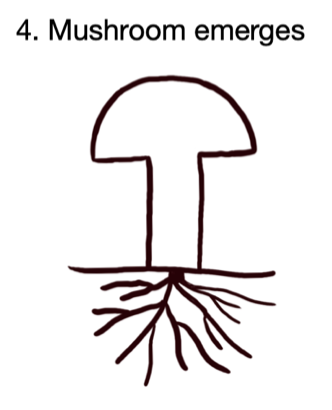 |
How does a mushroom emerge? When conditions are ideal, hyphae come together to form a small pinhead structure (primordium) underground. The primordium swells with water which causes it to emerge from the ground. The whole primordium has a covering called the universal veil. As the stalk (stipe) pushes upward, the universal veil tears. The bottom part remains around the base. This remnant is called the volva. The top part of the universal veil can sometimes be seen on the top of the cap (pileus). |
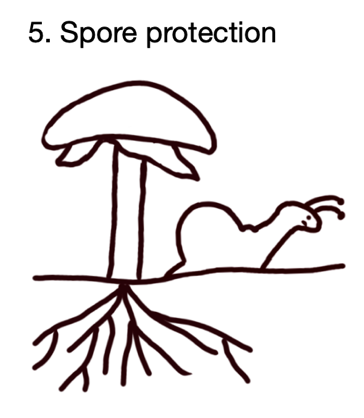 |
Where do spores form and how are they protected? Spores form on one of the surfaces of the mushroom cap. This special surface is called the hymenium. In Basidiomycota, it is usually on the underside of the cap. In Ascomycata, it is usually found on the upper surface of the mushroom. The hymenium is protected while it is forming and is exposed only when spores are developed and ready for release. |
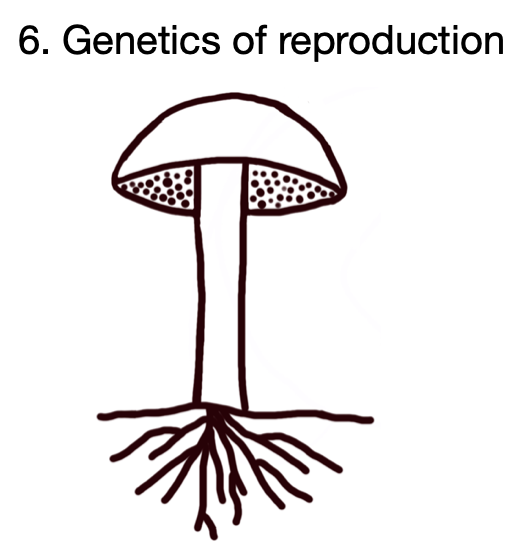 |
How do spores form? After mating, the mycelium grows underground in a dikaryotic state. This is the state where two nuclei (one from each parent) exist in each cell, but are kept separate so genetic material isn’t mixed yet. The cells make exact copies of themselves to keep growing the organism. This is the process of mitosis. Once the hymenium of the mushroom is developed, some cells remain unspecialized and form supporting structures. Other cells specialize and develop into reproductive cells. In these cells, the nuclei finally combine and mix their genetic material. This is the final step of fertilization, and this step is called karyogamy (karyo = “nut” + gamos = “marriage”). It results in a diploid (two sets of chromosomes) state. Fungus Fact: Humans have 23 pairs of chromosomes (46 chromosomes in the diploid state). There are 23 chromosomes in the haploid state that is found in reproductive cells (sperm and egg). In mushrooms, the number of chromosomes usually ranges from 6 to 16 chromosomes in the haploid set (12 to 32 chromosomes in a diploid set). Over the whole kingdom of fungi, the range of haploid chromosomes varies from 3 to 40, which means 6 to 80 chromosomes in a diploid set. After the nuclei combine, the sexual cells are ready to develop into spores. Each cell undergoes meiosis: first the chromosomes double, then they swap genes between chromosomes from each parent, then they divide two times, so that each spore gets a haploid number of chromosomes. In Basidiomycota, the process stops here and results in 4 spores from each initial sexual cell. In Ascomycota, the spores copy themselves one more time, resulting in 8 spores from each initial sexual cell. Fungus Fact: Fungi are the ONLY organisms that exist and reproduce with dikaryotic then diploid states. |
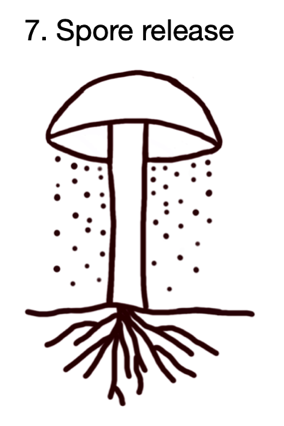 |
How are spores released? One of the key factors in spore release in both Ascomycota and Basidiomycota mushrooms is moisture. In Ascomycota fungi, the 8 spores are packed in structures called asci (singular: ascus). It looks like a sac, so Ascomycota are sometimes called “sac fungi”. When these sacs swell with water, the pressure builds up and shoots the spores out like a squirt gun or a cork popping off a champagne bottle. In Basidiomycota fungi, the 4 spores form from structures called basidia (singular: basidium). It looks like a club, so Basidiomycota are sometimes called “club fungi”. The spores are coated with a sugary layer that allows moisture to condense on them. Water condenses in two droplets: the round Buller’s drop and the flatter adaxial drop. When the Buller’s drop gets quite big, it touches the adaxial drop. The energy from these two drops meeting creates momentum that detaches the spore. This is quite forceful, so the spores are blasted off in the space between gills or pores, and then fall into the space below the hymenium. |
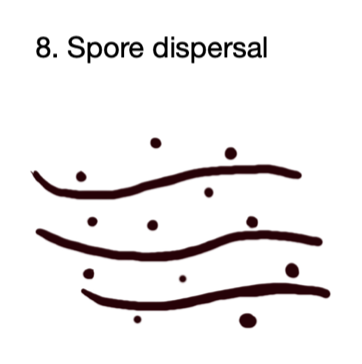 |
How are spores dispersed? In both the Ascomycota and Basidiomycota phyla, there are many ways fungi disperse their spores:
|
Strategies Fungi Use to Increase Reproductive Success
It is estimated that only 1 in a billion spores grows into a mycelium. Therefore, fungi use many strategies to increase their chances of reproducing successfully. I will describe the strategies for each step in the reproductive cycle in this table:
|
Step |
Strategies |
 |
Numbers of spores Each mushroom makes and releases millions to billions of spores.
Special features of spores Spores from different fungal species can vary in size, shape, colour, wall thickness, and other characteristics, which can optimize spore survival and success. The main challenges faced by spores are travel by wind or insects or animals, temperature stress, UV radiation, and each other. Variations:
Fungus Fact: Fungi were the first life forms to grow in the radioactive sites of Hiroshima and Chernobyl. |
 |
Compatibility and sexes (mating types) In fungi that form mushrooms, there are no male or female sexes. Instead, fungi have sexes that are called mating types. There are hundreds and even thousands of different mating types in each species. Some species of fungi have up to 36,000 mating types.
|
 |
Many mushrooms at once If the mycelium consumes the resources in one area, it will often expand outwards. When it encounters additional stresses (end of season/start of winter, competition with other fungi, low level of nutrients), it can form many mushrooms. Fungus Fact: When nutrients are low, the mycelium spreads outwards in a circle. When sporing bodies form, they pop out of the ground in a circular formation. In Europe, people called them “fairy rings” because they thought these circles were caused by fairies (and sometimes elves, pixies, witches, or dragons) dancing in a ring. In Alberta, the Blackfoot people believed they were formed by dancing bison. |
 |
Optimizing mushroom emergence The primordium can emerge from the ground quite forcefully. The whole primordium has a covering called the universal veil. The universal veil protects the mushroom as it emerges, increasing its chances of spore development, release, and dispersal. Fungus Fact: The stinkhorn can rise out of the ground as fast as 5 millimetres per minute. Other fungi rise so forcefully that they crack asphalt. |
 |
Optimizing spore numbers Fungi need to form millions to billions of spores. A good way to do this is with a very large spore-forming surface area. Many Basidiomycota increase their surface area by growing a hymenium that has gills, pores, or teeth. This allows the fungus to increase the surface area by 20 times! Fungus Fact: One mushroom in Africa, Termitomyces titanicus, can grow caps that are 1 metre wide. Without gills, the caps would need be 4.5 metres wide.
Protecting spores Different species have evolved various strategies to protect the developing spores. The main threats are water and animals. Some of the protective strategies are:
|
 |
Increasing genetic diversity The process of swapping genes between chromosomes from each parent, and then dividing them, is sexual reproduction. The main advantage of sexual reproduction for a species is to increase genetic diversity, and therefore, odds of survival.
|
 |
Two phyla, two main strategies for spore release The Ascomycota phylum and Basidiomycota phylum have many members. Each phyla has developed a characterstic strategy for spore release: In Ascomycota fungi, the 8 spores are packed in sacs called asci. When these sacs swell with water, the pressure builds up and shoots the spores out like champagne corks. In Basidiomycota fungi, the 4 spores form from club-like structures called basidia. When moisture condenses on the spores, it makes them pop off the basidia forcefully, and then drop down. |
 |
Methods of spore dispersal In both the Ascomycota and Basidiomycota phyla, there are many ways fungi disperse their spores. Most disperse spores by air, but some use water or animals. There are different strategies they use to increase dispersal: Dispersal by Air: A tall stalk lifts the hymenium higher which helps spores get carried away by wind. Gravity is very important for Basidiomycota, because the cap needs to be horizontal so spores fall straight down from gills, pores, or teeth. Dispersal by Water: this can play an important role in spore release. During storms, some fungi will delay spore release until the rainfall stops. Other fungi need water to release spores, such as bird’s nest fungi and puffballs. Dispersal by Animals: Some fungi need animals to help with dispersal (zoochory - zoo = “animal” + chory = “dispersal”). There are two main methods fungi use animals:
Some fungi have other, complex types of interactions with insects for spore dispersal:
|
The life cycle steps described above are used by species in both the Ascomycota and Basidiomycota phyla. They each use a wide variety of strategies to increase success at each step. As mentioned in Steps 7 and 8 (Spore Release and Dispersal), there are key differences between the two phyla. In the next section, I explored the differences and similarities in greater detail by comparing and contrasting multiple species in each phylum.
Data
This section compares spore release and spore dispersal in the Ascomycota and Basidiomycota phyla. Before doing this, let's review the basic life cycle and key strategies that allow fungi to optimize reproduction at each step.
Review of Life Cycle and Reproductive Success
1. How do mushroom-forming fungi reproduce?
The basic life cycle of a mushroom-forming fungus has these common features across all mushrooms:
- 1) A spore lands and grows a hypha.
- 2) Two hypha meet and mate if they are compatible.
- 3) The resulting mycelium feeds and grows, and will make a mushroom when it encounters stressors.
- 4) Some hyphae from the mycelium make a pinhead that swells with water, then grows and gets bigger, making a spore-forming surface.
- 5) The mushroom protects the developing spores.
- 6) The spores are formed when the genetic material from the two parent hyphae mix and divide the material among 4 spores. This process of mixing and dividing genetic material from two parents means that fungi reproduce sexually.
- 7) The spores are released.
- 8) The spores disperse, mostly by wind.
2. How do fungi increase their chances of reproductive success?
Fungi increase their reproductive success at every step of the life cycle:
- 1) Mushrooms make millions of spores. The spores have special features to withstand a variety of environmental conditions.
- 2) Fungi do not have male and female sexes. Instead, they have thousands of different sexes which are called mating types.
- 3) The mycelium will form mushrooms as a response to stressors (low food, lack of space, competitors), and it can make many mushrooms at once.
- 4) When the mushroom starts to form and emerge, it usually has two protective covers (veils) to protect it.
- 5) There are several ways mushrooms protect themselves, such as: the umbrella shape, partial veil, hard cover, sometimes a ball shape that contains the spores within it, hairs on the edges to repel animals, poison. Mushrooms can also increase the number of spores they make by having a folded spore-making surface.
- 6) Fungi have a very unique reproductive strategy to maximize genetic diversity. The parent hyphae only mix their genes and then divide them at the last moment when making spores. So every mixing event creates a different combination of genes for all the spores made.
- 7) Spore release is different in the two groups of fungi (Ascomycota and Basidiomycota). They each have different structures which leads to different ways of releasing spores. Ascos shoot spores up and Basidios drop spores down.
- 8) Spore dispersal is mostly by air, but can be by water and animals, including insects.
Comparison of Ascomycota and Basidiomycota
I looked at many species in the Ascomycota phylum (Ascos) and Basidiomycota phylum (Basidios), and compared and contrasted their appearances, and how that related to the fungal life cycle. I looked specifically at spore release and spore dispersal.
General Differences between Ascos and Basidios
In general, Ascos and Basidios make spores using different structures so they need to then release spores in different ways. This table compares and contrasts the basic structure of Ascos and Basidios:
| Ascomycota | Basidiomycota |
|
Ascos pack spores in long, narrow sacs and shoot them up like champagne corks. This photo shows many asci lined up beside each other. Each ascus is a long, narrow sac (blue colour) that contains 8 spores (brown/purple colour). |
Basidios develop spores on club-like structures, and then moisture on the spores causes them to pop off and fall down. This photo shows two basidia (green colour). Each basidium has 4 spores (brown colour) develop on it. |
|
Because Ascos shoot spores up, they are usually cup-shaped:
|
Because Basidios drop spores down, they are usually umbrella-shaped:
|
Comparison and Contrast of Ascos and Basidios
Exceptions to the usual forms can be found in both Ascos and Basidios, and many comparisons can be made, for both spore release and spore dispersal.
Spore Release
Ascos and Basidios can look similar or they can look different, but they often use similar methods to release spores:
| Observation | Description | Asco examples | Basidio examples | Notes |
| Same appearance, same function | ball shape, puffing |
flask fungi
|
puffball, cannonball
|
both Asco and Basidio examples look the same and both release spores upwards with puffing |
| Same appearance, same function | slimy looking |
Ascocoryne sarcoides (jellydisc)
|
witches butter (jelly fungus) - one of the exceptions in Basidios, with hymenium on the top surface
|
both Asco and Basidio examples look the same and both release spores upwards with spores sitting on top surface of fungus |
| Different appearance, same function | decay / melting |
asci melt in mazaedioid fungi (pinheads)
|
shaggy inkcap
|
both decay to improve spore release. The asci melt in pinheads, and the end of the cap deliquesces for the inkcap to drop spores. |
Spore Dispersal
Ascos and Basidios can look similar or they can look different, but they often use similar methods to disperse spores:
| Observation | Description | Asco examples | Basidio examples | Notes |
| Same appearance, same function | dispersal by wind |
tall stem in Helvella or morels
|
tall stem in Amanita
|
raising the stem up helps spores gets dispersed better |
| Same appearance, same function | dispersal by animals |
scarlet berry truffle - birds eat them
|
bird's nest - spore sacs land on grass, get eaten by deer
|
animals eat the spores |
| Different appearance, same function | dispersal by water |
inoperculate cup fungi - swell with water to expose the hymenium
|
bird's nest - need water to splash the spore sacs out
|
they look different but both need water for dispersal |
| Different appearance, same function | dispersal by insects |
Cordyceps - infects insects such as ants
|
stinkhorn - attracts flies
|
both need insects to help spread spores |
Unusual Exceptions
| Observation | Description | Asco examples | Basidio examples | Notes |
| Same appearance, different function | cup shape |
elf cup - curved surface faces up to shoot spores upwards
|
Podoscypha nitidula in Ecuador (a stereoid fungus) - looks like a cup but it stores water in the cup and releases spores from its outside surface
|
two fungi may look similar but they may be using the same shape to do different things (spore release vs staying moist) |
Summary
- Ascos and Basidios, in general, have different basic methods of releasing spores, so they usually have different appearances (Ascos are cups, Basidios are umbrellas), but exceptions exist in both phyla.
- Ascos and Basidios can look similar to each other, because both use similar strategies for spore release and dispersal.
- Ascos and Basidios can look different, but they are using similar methods of releasing and dispering spores.
- Sometimes, Ascos and Basidios can look very similar, but they are using that form or appearance to carry out very different functions.
Conclusion
Main Conclusion
1. Fungi use mushrooms for sexual reproduction.
- Mushrooms are centres for making and releasing spores.
- Spores carry genetic information from both parents.
Other Conclusions
2. Fungi use a wide variety of strategies to improve their chances of success when reproducing.
- They make millions of spores.
- They have thousands of sexes so it is easy to find a compatible mate.
- Spores are protected, released, and dispersed in many different ways.
3. Ascomycota and Basidiomycota have major differences in their usual basic structures. They can have some important similarities in appearance and in methods for spore release and dispersal.
Applications of Conclusions
Knowledge of fungal life and reproduction can be applied in many areas, including:
- Agriculture
- Most grocery stores sell only 5 varieties of mushrooms. Knowledge of fungal reproduction would help a business that wanted to farm and sell a wider variety of species.
- Many plant crops grow better with a symbiotic fungus. Farmers would need to know how to grow plants and fungi together.
- Forestry
- When replanting trees in a deforested area, it would be important to also grow symbiotic fungi.
- If there is an invasive tree species in a forest, a natural way to control it would be to encourage reproduction of a fungus that is parasitic on only that tree species.
- Fungal Control
- Mushrooms can pop up in gardens and on lawns where they are not wanted. One of the key things to know is that most of the organism is below ground as mycelium.
- Understanding fungal reproduction is important in controlling dangerous fungi that have started to grow in urban places, such as the death cap mushroom.
In the future, scientists will continue to discover more species of fungi, and our knowledge of fungal reproduction will expand even further.
Citations
Books (Print and Electronic)
Arora, D. (1986). Mushrooms demystified (2nd ed). Ten Speed Press.
Baliga, V. (2023). Plants to the rescue. Neon Squid.
Bellocq, A. (2015). Astounding mushrooms. Firefly Books.
Boddy, L. (2021). Humongous fungus: The weird and wonderful kingdom of fungi. DK Publishing Ltd.
Boddy, L., Clennett, C., Horobin, W., Jose, S., & Locke, J. (2023). Plants & Fungi. DK Publishing Ltd.
Briggs, G.M. (2024). Inanimate life. LibreTexts. https://bio.libretexts.org/Bookshelves/Botany/Inanimate_Life_(Briggs)
Bunyard, B.A. (2022). The lives of fungi: A natural history of our planet’s decomposers. Princeton University Press.
Chakrabarki, N. (2023). Hello fungi: A little guide to nature. Laurence King Publishing Ltd.
Clark, A.C., Choi, J. & Douglas, M. (2018). Biology 2e. OpenStax CNX. https://courses.lumenlearning.com/suny-osbiology2e/chapter/classifications-of-fungi/
Deacon, J. (2006). Fungal biology (4th ed). Blackwell Publishing.
Dorr, A. (2023). The Little book of mushrooms: An illustrated guide to the extraordinary power of mushrooms. Adams Media.
Ganesh, D. (Ed.) (2020). Supersimple biology: The ultimate bite-size study guide. DK Publishing Ltd.
Gravel, E. (2018). The mushroom fan club. Drawn & Quarterly.
Hawksworth, D.L., Suz, L.M., Kooij, P.W., Liimatainen, K., Prescott, T., Davies, L, & Gaya, E. (2019). Fungarium. Big Picture Press.
Hillis, D.M., Sadava, D., Hill, R.W., & Price, M.V. (2015). Principles of life (2nd ed). MacMillan Learning. https://www.macmillanhighered.com/BrainHoney/Resource/6716/digital_first_content/trunk/test/hillis2e/hillis2e_ch22_4.html
Keller, J. (2019). Fungus is among us. The Innovation Press.
Lim, M. & Shu, Y. (2022). The future is fungi: How fungi can feed us, heal us, free us, and save our world. Thames & Hudson.
Money, N.P. (2017). Mushrooms: A natural and cultural history. Reaktion Books Ltd.
Moore, D., Robson, G.D., & Trinci, A.P.J. (2021). 21st century guidebook to fungi (2nd ed.) Cambridge University Press. https://www.davidmoore.org.uk/21st_century_guidebook_to_fungi_platinum/
Morrow, M. (2024). A photographic atlas for botany. LibreTexts. https://bio.libretexts.org/Bookshelves/Botany/A_Photographic_Atlas_for_Botany_(Morrow)
Murphy, T.M, Rost, T.L., & Barbour, M.G. (2015). Plant biology. UC Davis. https://labs.plb.ucdavis.edu/courses/bis/1c/text/Chapter20nf.pdf
Stamets, P. (Ed.) (2019). Fantastic fungi: How mushrooms can heal, shift consciousness, & save the planet. Earth Aware Editions.
Starwood, J. (2021). Mushroom wanderland: A forager’s guide to finding, identifying, and using more than 25 wild fungi. The Countryman Press.
Electronic Sources (Articles and Websites)
Addy, H. (2022, October 3). What lies beneath: The hidden life of fungi. Nature Alberta. https://naturealberta.ca/what-lies-beneath-the-hidden-life-of-fungi/
British Mycological Society. (2024). Education & Outreach. British
Mycological Society. https://www.britmycolsoc.org.uk/education
Fearnley, K. (2016, July 5). Weird & wonderful creatures: Bleeding Tooth Fungus. American Association for the Advancement of Science. https://www.aaas.org/news/weird-wonderful-creatures-bleeding-tooth-fungus#:~:text=When%20young%20and%20actively%20growing,by%20a%20process%20called%20guttation.
Hanrahan-Tan, D.G., Lilje, O., & Henderson, L. (2023). Chytrids in soil environments: unique adaptations and distributions. Encyclopedia, 3(2):642-664. https://doi.org/10.3390/encyclopedia3020046
Hassett, M.O., Fischer, M.W.F., & Money, N.P. (2015). Mushrooms as rainmakers: How spores act as nuclei for raindrops. PLoS ONE, 10(10):e0140407. doi:10.1371/journal.pone0140407.
Hsu, H. (2020, May 11). The secret lives of fungi. The New Yorker. https://www.newyorker.com/magazine/2020/05/18/the-secret-lives-of-fungi
Intermountain Herbarium. (n.d.) Earth stars. Utah State University. https://www.usu.edu/herbarium/education/fun-facts-about-fungi/earth-stars
Isaac, S. (1994-1998). Mycology answers. Mycologist. https://www.davidmoore.org.uk/Assets/fungi4schools/FAQs.htm
Kingdom (biology) facts for kids. (2023, November 6). Kiddle encyclopedia. https://kids.kiddle.co/Kingdom_(biology)
Lepp, H. (2012, November 19). Fungi. Australian National Botanical Gardens. https://www.anbg.gov.au/fungi/index.html
Malloch, M. (2021, June 28). Spore Prints. Mycology Web Pages. http://website.nbm-mnb.ca/mycologywebpages/EssaysOnFungi/Collecting_mushrooms_for_scientific_study/Spore_print.html
Marriott, J.V.R. (1988-1989). First steps: the jargon explained and illustrated. Mycologist. https://www.davidmoore.org.uk/Assets/fungi4schools/Beginners_page.htm#Jargon
Moore, D. (2018, Oct 10). Fungi 4 Schools. British Mycological Society. https://www.davidmoore.org.uk/Assets/fungi4schools/index.htm
MycologyStart. (2023). Ascomycota. MycologyStart. https://mycologyst.art/kingdom-fungi/ascomycota/
NatureScot. (2020, November 13). The herald of winter - and other November fungi. Scotland’s Nature. https://scotlandsnature.blog/2020/11/13/the-herald-of-winter-and-other-november-fungi/
New Forest National Park Authority. (n.d.) Shaggy inkcap. New Forest National Park. https://www.newforestnpa.gov.uk/discover/plants-fungi/fungi/shaggy-inkcap/#:~:text=The%20crowded%20gills%20underneath%20the,important%20dispersal%20of%20the%20spores
Rogers, G. (n.d.). Lesson 2: Fungi. Botany Companion. https://botanycompanion.wordpress.com/model-page-fungi/
Sherratt, T.N., Wilkinson, D.M., & Bain, R.S. (2004). Explaining Dioscorides’ “double difference”: why are some mushrooms poisonous, and do they signal their unprofitability? The American Naturalist, 166(6):767-775.
SlideServe. (n.d.) Ascomycetes: Phylum Ascomycota. SlideServe. https://www.slideserve.com/kimi/ascomycetes-phylum-ascomycota
Tadlock, D. (n.d.) Building the tree of life. East Tennessee State University. https://www.etsu.edu/uschool/faculty/tadlockd/documents/bio_chpt18sec3show.pdf
Urban Mushrooms. (2011). How to identify mushrooms and where to find them. Urban Mushrooms. https://urbanmushrooms.com/index.php?id=69
White, C. (2023, September 6). How many sexes do mushrooms have? Fungus can have up to 36,000 mating types. The Science Times. https://www.sciencetimes.com/articles/45827/20230906/many-sexes-mushrooms-fungus-up-36-000-mating-types.htm
Audiovisual Media
Movies
Marciniak, C. (Director). (2022). Planet Fungi safari in remote northeast India [Film]. Planet Fungi.
Ogrodowczyk, M. (Director). (2022). The life of the forest: Fungi [Film]. Forest Film Studio.
Schwartzberg, L. (Director). (2019). Fantastic Fungi [Film]. Moving Art.
Talas, A. & Nasht, S. (Directors). (2018). The Kingdom: How fungi made our world [Film]. Real to Reel Productions, Smith & Nasht.
Podcasts
Dorr, A. (Executive Producer). (2019 - present). Mushroom Revival [Audio podcast]. Mushroom Revival Inc. https://www.mushroomrevival.com/blogs/podcast
Youtube Videos
Havranek, C. (2020, October 6). The fungi of Antarctica [Video]. British Antarctic Survey / Youtube. https://www.bas.ac.uk/event/new-film-release-the-fungi-of-antarctica-with-claudia-havranek/
MooMooMath and Science. (2018, May 3). The 6 kingdoms of classification in 3 minutes [Video]. Youtube. https://www.youtube.com/watch?v=aH5ST8gmSCU
Planet Fungi. (2020, September 4). Stephen Axford: How fungi changed my view of the world [Video]. Youtube. https://www.youtube.com/watch?v=KYunPJQWZ1o
Additional Thanks
Thank you to:
Dr. Heather Addy (Professor Emeritus, University of Calgary)
Dr. Toby Spribille (Professor, University of Alberta)
For their suggestions of useful books and other resources
Photo Credits
Biology 2e
AC Clark
Flickr
Bernard Spragg
Björn S...
Brian Gratwicke
budak
Carlos Andrés Reyes
Cataloging Nature
Derek Parker
Diana Padrón
Donald Hobern
Ed Uthman
Frank Vassen
hedera.baltica
José Roberto Peruca
Juan Sevilla
Katja Schulz
Lukas Large
Marjan Kustera
Patrick Schifferli
Richard Droker
T
Tim Haye
TJ Gehling
unokorno
Wayne W G
Pixabay
adege
Illuvis
meineresterampe
OpenClipart-Vectors
PetrFromMoravia
Pix
RitaE
tphananh
Wikimedia Commons
Alan Rockefeller
Atsushi Nakajima
David Stang
dugald
Evelyn Simak
Jon Houseman
jrussula
M. Piepenbring
Nefronus
Olga Aleksandra
Randal
Tobi Kellner
Youtube
Deep Look
Acknowledgement
Thank you to:
My mentor: my mother
My school science fair coordinator: Ms. Heather Lai
Thank you also to:
Dr. Heather Addy (Professor Emeritus, University of Calgary)
Dr. Toby Spribille (Professor, University of Alberta)
For their suggestions of useful books and other resources

